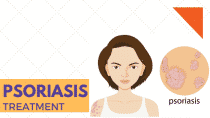Psoriasis is a common, chronic skin condition that has a characteristic clinical and histological appearance but has various clinical presentations.

The severity of psoriasis ranges from asymptomatic thin localized plaques that are an incidental finding, to widespread generalized plaques. or rarely, complete erythroderma.
Severity is often assessed as a total- body surface area (BSA) affected. where the patient’s palm – 1% BSA. Greater than 10% of BSA is considered to be severe.
However, less BSA involvement can still be severe if it significantly interferes with an individual’s quality of life
Table of Contents
Pathophysiology of Psoriasis
Psoriasis is an immunologically based inflammatory skin condition that results in abnormal epidermal differentiation and hyperproliferation.
Psoriasis is more likely to occur in persons with a genetic predisposition. Genome-wide association studies have revealed that psoriasis susceptibility genes have immune-related functions.
The inflammatory process is triggered and maintained by Th1, Th17. and Th22 cells and their corresponding proinflammatory cytokines, tumor necrosis factor-alpha (TNF-a) and IFN-y, IL-17, and IL-22.
The lesions of psoriasis result from a dramatic activation of keratinocyte proliferation.
Such a “turned-on” epidermis. with a rapid accumulation of cells and no time for shedding, accounts for the characteristic lesion of psoriasis: a red papule or plaque with a buildup white or silvery (micaceous) scale. Uncommonly, lesions may be very thick and verrucous.
An ongoing vigorous investigation into the pathogenesis of psoriasis has resulted in a multitude of new effective, targeted therapies.
Histopathology of Psoriasis
The histopathology findings demodulate the altered cell kinetics or psoriasis.
Marked thickening (Acanthosis) as well as thinning of the epidermis with resultant elongation of the rete ridges.
Parakcrato (nuclei retained in the stratum corneum). Dermal inflammation (lymphocytes and monocytes) and dilation of dermal blood vessels.
Epidermal inflammation (polymorph nuclear cells) in the stratum corneum that may form the so-called micro-abscesses of Munro.
Clinical Manifestations
Lesions or psoriasis are characterized by well-demarcated pink papules or plaques with, silvery-white scale.
Lesions tend to be remarkably symmetric in their distribution.
Psoriasis can present in various clinical forms (listed below) and a single patient may have multiple forms throughout his or her lifetime.
- Generalised plaque psoriasis
- Guttate psoriasis-Inverse psoriasis
- Palm plantar psoriasis
- Scalp psoriasis
- Nail psoriasis
Triggers
Factors that may adversely influence psoriasis include the following:
- Stress
- Alcohol
- Drugs
- Physiol trauma
- Sunlight
Diagnosis
The diagnosis of psoriasis is usually made on clinically grounds.
A skin biopsy or fungal studies may be performed to rule in or rule out other possible diagnoses.
Do you want to know more? Then click here to know about What is Homeopathy.
Homeopathy & Psoriasis
In Homeopathy Psoriasis treatment is quick and beneficial. Around the globe, thousands of patients get treatment of psoriasis with homeopathic medicines.
Homeopathic Medicine for Psoriasis Treatment
Here are the following Homeopathic Medicines for the treatment of Psoriasis.
Arsenicum Album
When other symptoms of the remedy are present and there is irritation of the skin. its first influence is to make eruptions, redder and more inflamed. There is a burning sensation that is relieved by the warmth it is a good sign for the use of Arsenicum Album Homeopathic Medicine.
Calotropis
Psoriasis of syphilitic patients in the second stage when the mercury has stopped doing further good.
Carcinocinum
As an intercurrent remedy ensures prompt cure.
Chrysarobium
If the nails become dull. develop ridges and pits, and the cause is psoriasis. Vesicular lesions with felid discharge and crust formation Violent itching. Thighs, legs, and ears especially affected.
Cicuta Vir
Spots having burning pains when touched. Many irritating eruptions on the ears.
Corallium Rub
Psoriasis of palms and soles.
Cuprum met
Chronic psoriasis. Few spots itch, worse in the folds of joints. The skin is bluish.
Graphites
If the crust is sticky and glutinous and the patient is constipated and cautious.
Hepar Sulph
Patients are over-sensitive to changes in weather especially from dry to cold. und desires warmth.
Hydrocotyle
Psoriasis of soles, palms, trunks, and extremities with circular patches. The skin is excessively thick and dry. Circular spots with scaly edges.
Lycopodium
Psoriasis or fungus Sruwth on palms Skin is dry and shrunken.
Mezereum
Psoriasis of palms. Itching worse with warmth.
Petroleum
Thick, greenish crusts. Burning and itching especially in psoriasis of hands with fissures. Aggravation by cold and in winter.
Psorinum
Skin looks dirty and there is much itching which is worse by the warmth of bed. Crusts disappear in summer und reappear in winter.
Sulphur
The patient is dirty and has an aversion to bathing. Dry scally an unhealthy skin. Burning and itching. The disease is worse in springtime and in damp weather.
Tuberculinum
Chronic psoriasis with intense itching worse at night. It is particularly indicated in tuberculous children and patients having a history of tuberculous in the family.

